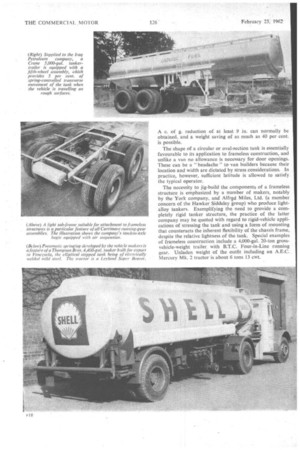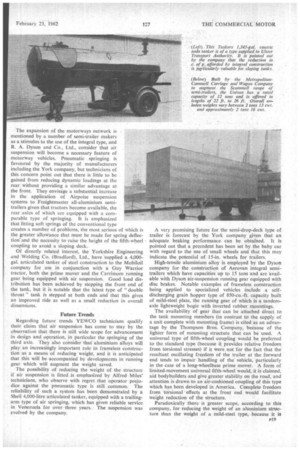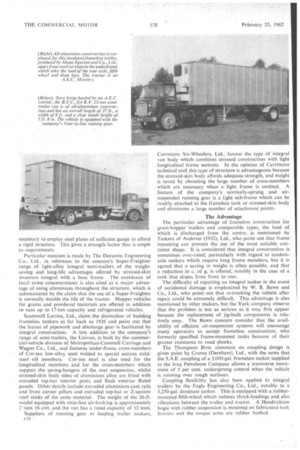LIGHT, LOW AND TOUG
Page 86

Page 88

Page 89

Page 90

If you've noticed an error in this article please click here to report it so we can fix it.
EXPLOITING the potential advantages -of. . frameless construction for tankers and vans is a highly. technical exercise, and although its application to semi-trailers is facilitated by the reduction in torsional stresses offered by the coupling, the production of such vehicles involves intensive development work if the maximum benefits 'arcto be obtained. Many integral bodies are jig-built on "aircraft lines" following detailed study of complex stress problems, and advances made in design of integral semi-trailers in recent years represent a valuable contribution to bodywork theory, and practice, Relatively few years ago, it was generally assumed that a framed structure was preferable to the integrartype for particularly arduous conditions, but this is now refuted by a number of Makers. It is significant, however, that a suspensitin sYstern'giving a substantially constant-periodicity characteristic generally offers greater advantages to the designer of frameless vehicles because of the rigidity of the structure. The main-frame Of a so-called rigid vehicle is virtually a part of the suspension system, and it is normal for the bodywork or mountings to be designed to give adequate flexibility. In contrast, flexing must be eliminated or reduced to a marginal value in the case of a fully stressed integral body to-obviate fatigue fractures, and the body may be more susceptible to 'damage by high-frequency vibrations when the vehicle is running light.
To the van user, the most important advantage of integral trailer construction is a substantial saving in weight, and it is significant that construction has been eoncentrated on
light-alloy units, all the 'components of which are Jully stressed members._ A measure of the saving obtainable is indicated by the York Trailer Co., Ltd., with the claim that a. frameless van trailer can be built Which is virtually no heavier than a comparable platform type. The concern's Freightmaster light-alloy -tandem-axle van has an unladen Weight of 3 tons .15. -cwt. (when -equipped with Airpoise suspension) and an export payload rating of 20 tons. The proportionate weight-saving afforded by integral construction is about 20 per cent.
It is notable that the use of multiple side pillars, robust corner castings, special extruded quarter panels and so on affords a particularly rigid structure, the strength of which was fully proved when (as reported in the April 28, 1961 • issue of The Commercial Motor) the driver of a Flowers Atkinson-Freightmaster combination was forced to run into a deep ditch to avoid a head-on collision. Loaded with beer bottles, the vehicle structure showed no evidence of misalignment after recovery.
An integral van may also be built with a somewhat lower floor, but this advantage is small compared with the relatively greater reduction in the centre of gravity of a tanker provided by frameless construction by virtue of the tank's shape. Because the load of a tanker occupies the entire carrying space, a lower c. of g. improves handling of the Vehicle on the road, as well as facilitating a saving in weight, and is cited by technicians of Thompson Bros, (Bilston), Ltd., as the main advantage of integral design. A e. of g. reduction of at least 9 in. can normally be obtained, and a weight saving of as much as 40 per cent. is possible.
The shape of a circular or oval-section tank is essentially favourable to its application to frameless construction, and unlike a van no allowance is necessary for door openings. These can be a " headache " to van builders because their location and width are dictated by stress considerations. In practice, however, sufficient latitude is allowed to satisfy the typical operator.
The necessity to jig-build the components of a frameless structure is emphasized by a number of makers, notably by the York company, and Alfred Miles, Ltd. (a member concern of the Hawker Siddeley group) who produce lightalloy tankers. Exemplifying the need to provide a completely rigid tanker structure, the practice of the latter company may be quoted with regard to rigid-vehicle applications of stressing the tank and using a form of mounting that counteracts the inherent flexibility of the chassis frame, despite the relative lightness of the tank. Special examples of frameless construction include a 4,000-gal. 20-ton grossvehicle-weight trailer. with B.T.C. Four-in-Line running gear. Unladen weight of the outfit including an A.E.C. Mercury Mk. 2 tractor is about 6 tons 13 cwt.
The expansion of the motorways network is mentioned by a number of semi-trailer makers as a stimulus to the use of the integral type, and R. A. Dyson and Co., Ltd., consider that air suspension will become a necessary feature of motorway vehicles. Pneumatic springing is favoured by the majority of manufacturers including the York company, but technicians of this concern point out that there is little to be gained from reducing dynamic loadings at the rear without providing a similar advantage at the front. They envisage a substantial increase in the application of Airpoise suspension systems to Freightmaster all-aluminium semitrailers given that tractors become available, the rear axles of which are equipped with a comparable type of springing. It is emphasized that fitting soft springs of the conventional type creates a number of problems, the most serious of which is the greater allowance that must be made for spring deflection-and the necessity to raise the height of the fifth-wheel coupling to avoid a sloping deck.
Of directly related interest, the Yorkshire Engineering and Welding Co. (Bradford), Ltd., have supplied a 4,000gal. articulated tanker of steel construction to the Mobiloil company for use in conjunction with a Guy Warrior tractor, both the prime mover and the Carrimore running gear being equipped with air suspension. Good load distribution has been achieved by stepping the front end of the tank, but it is notable that the latest type of "double throat" tank is stepped at both ends and that this gives an improved ride as well as a small reduction in overall dimensions.
Future Trends
Regarding future trends YEWCO technicians qualify their claim that air suspension has come to stay by the observation that there is still wide scope for advancement in design and operation, in particular the springing of the third axle. They also consider that aluminium alloys will play an increasingly important role in frameless construction as a means of reducing weight, arid it is anticipated that this will be accompanied by developments in running gear which will augment the weight saved.
The possibility of reducing the weight of the structure if air suspension is fitted is emphasized by Alfred Miles' technicians, who observe with regret that operator prejudice against the pneumatic type is still common. The reliability of such a system has been demonstrated by a Shell 4,000-litre articulated tanker, equipped with a trailingarm type of air springing, which has given reliable service in Venezuela for over three years. The suspension was evolved by the company. A very promising future for the semi-drop-deck type of trailer is forecast by the York company given that an adequate braking performance can be obtained. It is pointed out that a precedent has been set by the baby car with regard to the use of small wheels and that this may indicate the potential of 15-in, wheels for trailers.
High-tensile aluminium alloy is employed by the Dyson company for the construction of Aerovan integral semitrailers which have capacities up to 15 tons and are -available with Dyson air-suspension running gear equipped with disc brakes. Notable examples of frameless construction being applied to specialized vehicles include a selfdischarging grain hopper type of 850-cu.-ft. capacity built of mild-steel plate, the running gear of which is a tandemaxle lightweight bogie with inverted rubber mountings.
The availability of gear that can be attached direct to the tank mounting members (in contrast to the supply of a unit complete with mounting frame) is cited as an advantage by the Thompson Bros. Company, because of the lighter form of mounting structure that can be used. A universal type of fifth-wheel coupling would be preferred to the standard type (because it provides relative freedom from torsional stresses) if it were not for the fact that the resultant oscillating freedom of the trailer at the forward end tends to impair handling of the vehicle, particularly in the case of a long-wheelbase prime mover. A form of limited-movement universal fifth-wheel would, it is claimed, aid bodybuilders and give greater stability on the road, and attention is drawn to an air-cushioned coupling of this type which has been developed in America. Complete freedom from torsional effects at the front end would facilitate weight reduction of the structure.
Paradoxically there is greater scope, according to this company, for reducing the weight of an aluminium structure than the weight of a mild-steel type, because it is F19
necessary to employ steel plates of sufficient gauge to afford a rigid structure. This gives a strength factor that is ample to requirements.
Particular mention is made by The Durarnin Engineering Co., Ltd., in reference to the concern's Super-Freighter range of light-alloy integral semi-trailers of the weightsaving and long-life advantages offered by stressed-skin structure integral with a base frame. The avoidance of local stress concentrations is also cited as a major advantage of using aluminium throughout the structure, which is substantiated by the claim that the use of a Super-Freighter is normally double the life of the tractor. Hopper vehicles for grains and powdeted materials are offered in addition to vans up to 17-ton capacity and refrigerated_ vehicles.
Scammell Lorries, Ltd., claim the distinction of building frameless tankers as far back as 1926 and point out that the layout of pipework and discharge gear is facilitated by integral construction. A late addition to the company's range of semi-trailers, the Univan, is built by the commercial-vehicle division of Metropolitan-Catnmell Carriage and Wagon Co.. Ltd., and features under-frame cross-members of Car-ten low-alloy steel welded to special section mildsteel sill members. Cor-ten steel is also used for the longitudinal members and for the cross-members which support the spring-hangers of the rear suspension, whilst stressed-skin body sides of aluminium alloy are fitted with extruded top-hat interior posts and flush exterior fluted panels. Other details include extruded aluminium cant rails and front corner pillars and extruded top-hat or Z-section roof sticks of the same material. The weight of the 26-ft. model equipped with twin-line air-braking is approximately 2 tons 16 cwt. and the van has a rated capacity of 12 tons.
Suppliers of running gear to leading trailer makers, F20 Carrinnore Six-Wheelers, Ltd., favour the type of integral van body which combines stressed construction with light longitudinal frame sections. In the opinion of Carrimore technical staff this type of structure is advantageous because the stressed-skin body affords adequate strength, and weight is saved by obviating the large number of cross-members which are necessary when a light frame is omitted. A feature of the company's normally-sprung and airsuspended running gear is a light sub-frame which can be readily attached to the frameless tank or stressed-skin body and eliminates a large number of attachment points.
The Advantage The particular advantage of frameless construction for grain-hopper trailers and comparable types, the load of which is discharged from the centre, is mentioned by Taskers of Andover (1932), Ltd., who point out that frame mounting can prevent the use of the most suitable container shape. It is considered that integral construction is sometimes over-rated, particularly with regard to tandemaxle tankers which require long frame members, but it is agreed that a saving in weight is often possible, and that a reduction in c. of g. is offered, notably in the case of a tank that slopes from front to rear.
. The difficulty of repairing an integral tanker in the event of accidental damage is emphasized by W. B. Bawn and Co., Ltd., who point out that re-tracking the vehicle after repair could be extremely difficult. This advantage is also mentioned by other makers, but the York company observe that the problem is not as serious as it may first appear because the replacement of jig-built components is relatively easy. The Bawn concern consider that the availability of efficient air-suspension systems will encourage mans' operators to accept frameless construction, who formerly specified frame-mounted tanks because of their greater resistance to road shocks.
The Thompson Bros. comment on coupling design is given point by Cranes (Dereham), Ltd., with the news that the S.A.E. coupling of a 5,000-gal. frameless tanker supplied to the Iraq Petroleum Company allows a transverse movement of 5 per cent. undersprung control when the vehicle is running over rough surfaces.
Coupling flexibility has also been applied to integral trailers by the Eagle Engineering Co., Ltd., notably to a 3,250-gal. dresinate tanker. This is equipped with a rubbermounted fifth-wheel which reduces shock-loadings and also vibrations between the trailer and tractor. A Hendrickson bogie with rubber suspension is mounted on fabricated tank bearers and the torque arms are rubber bushed.












































































































































































